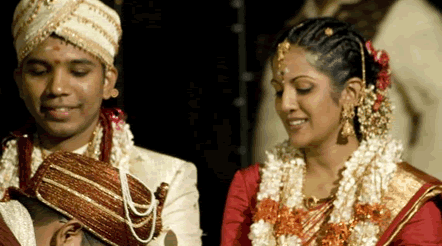
|
| Tamilian
Wedding Culture and Traditions 'Paalikali Thalippu' is a ceremony which is performed two days before marriage where small clay pots are decorated with sandal paste and kumkum. A little curd is put in each pot and nine types of grains are sprinkled. Then they are watered by the married ladies of both sides. After the marriage, couple throws these pots with sprouted grains in nearby pond. This is done to seek the blessings of the fish in the water. 'Kalyanaponnu' is another important ceremony which is performed before marriage at the houses of the girl and the boy. Seasem oil is put on the girl and she is given a green saree with green and red bangles. Girl is put to confinement till marriage. Groom's father also puts oil on him and gives him cash and clothes. He is also confined at a place till marriage. 'Panda kaal muhuratham' is the ceremony which is held a day before marriage and the family gather to seek the blessings of the family diety. This is done so that everything goes on smoothly. One day before marriage, groom and his family reaches the house of the bride where they are welcomed by the parents of the bride. They are offered supari, misri, flowers and fruits. Sandalwood is applied on the boy's forehead. Sweet dish is offered to the groom's parents. A coconut is broken to ward off evil spirits. The ancestors of the both families are remembered and the priests are invited to have meals and they are given clothes, sweets, fruits, supari and paan. Ganesh puja is performed by the parents of the bride along with the priest. Bride is given sari by the groom's parents. Chandan and kumkum are applied on her forehead. Her sari is filled with fruits, turmeric and coconut. Puja is performed of her. On the wedding morning, bride and groom sit on wooden stools. Turmeric, kumkum and oil are put on the both and arti is performed. Then they are given clothes. They go to their respective homes and dress up for the wedding. After the mangalsanamam, the groom pretends to go for kashi on a pilgrimage, but he is stopped by the bride's father. He comes back to pandal where bride is waiting for her. They exchange garlands thrice. Now, they sit together on swings and balls of cooked rice with saffron are thrown in various directions to ward off evil spirits. The couple is served milk and banana. This ceremony is called 'Oonjal'. After this, kanaydanam is held. The corner of the girl's sari is tied with the shawl of the boy. Their right hands are tied with a thread. As they each the mandav, boy's feet are washed by the bride's father. Bride sits on the lap of her father holding a coconut and offers it to the groom. This way girl is given to the groom. She is presented a sari by the groom's parents which she wraps around. She sits in the lap of her father on the heap of paddy to welcome prosperity. Plough is touched to her forehead. Groom ties mangalsutra to the neck of the girl. The groom takes the right hand of the girl with his left hand and takes seven rounds around the fire. Girl starts each round by touching the grinding stone. With this, marriage ceremony is complete. Good
wishes and blessings are showered on the couple.
|
